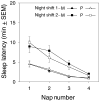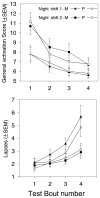Effects of melatonin administration on daytime sleep after simulated night shift work - PubMed (original) (raw)
Clinical Trial
Effects of melatonin administration on daytime sleep after simulated night shift work
K M Sharkey et al. J Sleep Res. 2001 Sep.
Abstract
Disturbed sleep and on-the-job sleepiness are widespread problems among night shift workers. The pineal hormone melatonin may prove to be a useful treatment because it has both sleep-promoting and circadian phase-shifting effects. This study was designed to isolate melatonin's sleep-promoting effects, and to determine whether melatonin could improve daytime sleep and thus improve night time alertness and performance during the night shift. The study utilized a placebo-controlled, double-blind, cross-over design. Subjects (n=21, mean age=27.0 +/- 5.0 years) participated in two 6-day laboratory sessions. Each session included one adaptation night, two baseline nights, two consecutive 8-h night shifts followed by 8-h daytime sleep episodes and one recovery night. Subjects took 1.8 mg sustained-release melatonin 0.5 h before the two daytime sleep episodes during one session, and placebo before the daytime sleep episodes during the other session. Sleep was recorded using polysomnography. Sleepiness, performance, and mood during the night shifts were evaluated using the multiple sleep latency test (MSLT) and a computerized neurobehavioral testing battery. Melatonin prevented the decrease in sleep time during daytime sleep relative to baseline, but only on the first day of melatonin administration. Melatonin increased sleep time more in subjects who demonstrated difficulty in sleeping during the day. Melatonin had no effect on alertness on the MSLT, or performance and mood during the night shift. There were no hangover effects from melatonin administration. These findings suggest that although melatonin can help night workers obtain more sleep during the day, they are still likely to face difficulties working at night because of circadian rhythm misalignment. The possibility of tolerance to the sleep-promoting effects of melatonin across more than 1 day needs further investigation.
Figures
Figure 1
Sample protocol diagram for a participant with baseline sleep scheduled from 00:00 to 08:00 h. Each subject participated in the protocol twice; melatonin was administered during one session and placebo was administered during the other session. B1 = Baseline 1; B2 = Baseline 2; D1 = Day Sleep 1; D2 = Day Sleep 2; R = recovery.
Figure 2
Total sleep times (mean ± SEM) recorded with polysomnography during the melatonin session (●) and placebo session (○). B1 = Baseline 1; B2 = Baseline 2; D1 = Day Sleep 1; D2 = Day Sleep 2; R = Recovery. Melatonin or placebo was administered 0.5 h before sleep on D1 and D2. Time in bed was 8 h. n = 21, *P < 0.05 between melatonin and placebo.
Figure 3
Amount of polysomnographic sleep (mean ± SEM) during the first and second halves of the day sleep episodes (first and last 4 h) during the melatonin session (●) and the placebo session (○). *P < 0.05 between melatonin and placebo.
Figure 4
Average Stanford sleepiness scale ratings (mean ± SEM) from bedtime questionnaires, wake time questionnaires, and test bouts during the night shifts. 1 = ‘feeling active and vital; alert; wide awake’ and 7 = ‘almost in reverie; sleep onset soon; must struggle to remain awake.’ (●) The melatonin session, (○) the placebo session. B = Bed-time ratings; W = Wake time ratings; numbers 1–4 indicate the sequential test bouts during the night shifts. *P < 0.01.
Figure 5
Average sleep latencies (mean ± SEM) from the four MSLT naps administered during the night shifts. M = Melatonin session; P = Placebo session. Filled symbols indicate the melatonin session and open symbols indicate the placebo session. Triangles indicate the first night shift and boxes indicate the second night shift.
Figure 6
Examples of performance test results from the neurobehavioural assessment battery during the night shifts. Filled symbols indicate the melatonin session and open symbols indicate the placebo session. Triangles indicate the first night shift and boxes indicate the second night shift. Top: General activation (GA) scores (mean ± SEM) from the activation–deactivation adjective checklist (ADACL). To complete the ADACL, subjects rated 20 adjectives on whether they described their mood at the time of the test battery. The four possible ratings were ‘definitely feel’, ‘feel slightly’, ‘cannot decide at the moment’ and ‘definitely do not feel.’ The GA subscore is compiled from subjects’ responses to five descriptors (full-of-pep, active, vigorous, energetic, and lively). Bottom: Lapses (mean ± SEM) on the psychomotor vigilance task (PVT). This task measures visual reaction time during a 10-min vigilance task, and any reaction time longer than 0.5 s is considered a lapse. Lapses are plotted as the square root transformation of the number of reaction times >0.5 s.
Similar articles
- Complete or partial circadian re-entrainment improves performance, alertness, and mood during night-shift work.
Crowley SJ, Lee C, Tseng CY, Fogg LF, Eastman CI. Crowley SJ, et al. Sleep. 2004 Sep 15;27(6):1077-87. doi: 10.1093/sleep/27.6.1077. Sleep. 2004. PMID: 15532201 - The effects of melatonin on sleep-wake rhythm of daytime haemodialysis patients: a randomized, placebo-controlled, cross-over study (EMSCAP study).
Koch BC, Nagtegaal JE, Hagen EC, van der Westerlaken MM, Boringa JB, Kerkhof GA, Ter Wee PM. Koch BC, et al. Br J Clin Pharmacol. 2009 Jan;67(1):68-75. doi: 10.1111/j.1365-2125.2008.03320.x. Epub 2008 Nov 17. Br J Clin Pharmacol. 2009. PMID: 19076157 Free PMC article. Clinical Trial. - Pharmacological interventions for sleepiness and sleep disturbances caused by shift work.
Liira J, Verbeek JH, Costa G, Driscoll TR, Sallinen M, Isotalo LK, Ruotsalainen JH. Liira J, et al. Cochrane Database Syst Rev. 2014 Aug 12;2014(8):CD009776. doi: 10.1002/14651858.CD009776.pub2. Cochrane Database Syst Rev. 2014. PMID: 25113164 Free PMC article. Review. - Morning melatonin has limited benefit as a soporific for daytime sleep after night work.
Smith MR, Lee C, Crowley SJ, Fogg LF, Eastman CI. Smith MR, et al. Chronobiol Int. 2005;22(5):873-88. doi: 10.1080/09636410500292861. Chronobiol Int. 2005. PMID: 16298773 Clinical Trial. - Use of melatonin in circadian rhythm disorders and following phase shifts.
Skene DJ, Deacon S, Arendt J. Skene DJ, et al. Acta Neurobiol Exp (Wars). 1996;56(1):359-62. doi: 10.55782/ane-1996-1139. Acta Neurobiol Exp (Wars). 1996. PMID: 8787196 Review.
Cited by
- Pharmacotherapeutic Considerations on Telomere Biology: The Positive Effect of Pharmacologically Active Substances on Telomere Length.
Apetroaei MM, Fragkiadaki P, Velescu BȘ, Baliou S, Renieri E, Dinu-Pirvu CE, Drăgănescu D, Vlăsceanu AM, Nedea MII, Udeanu DI, Docea AO, Tsatsakis A, Arsene AL. Apetroaei MM, et al. Int J Mol Sci. 2024 Jul 13;25(14):7694. doi: 10.3390/ijms25147694. Int J Mol Sci. 2024. PMID: 39062937 Free PMC article. Review. - Stories from a life studying circadian rhythms and sleep.
Eastman C. Eastman C. Sleep Adv. 2023 Dec 10;4(1):zpad040. doi: 10.1093/sleepadvances/zpad040. eCollection 2023. Sleep Adv. 2023. PMID: 38084297 Free PMC article. No abstract available. - Recovery from shift work.
Kalkanis A, Demolder S, Papadopoulos D, Testelmans D, Buyse B. Kalkanis A, et al. Front Neurol. 2023 Nov 2;14:1270043. doi: 10.3389/fneur.2023.1270043. eCollection 2023. Front Neurol. 2023. PMID: 38020633 Free PMC article. Review. - Pressure Building Against the Clock: The Impact of Circadian Misalignment on Blood Pressure.
Shafer BM, Kogan SA, McHill AW. Shafer BM, et al. Curr Hypertens Rep. 2024 Jan;26(1):31-42. doi: 10.1007/s11906-023-01274-0. Epub 2023 Oct 14. Curr Hypertens Rep. 2024. PMID: 37837518 Review. - Narrative review: The role of circadian rhythm on sports performance, hormonal regulation, immune system function, and injury prevention in athletes.
Nobari H, Azarian S, Saedmocheshi S, Valdés-Badilla P, García Calvo T. Nobari H, et al. Heliyon. 2023 Sep 1;9(9):e19636. doi: 10.1016/j.heliyon.2023.e19636. eCollection 2023 Sep. Heliyon. 2023. PMID: 37809566 Free PMC article. Review.
References
- Akerstedt T. Psychological and psychophysiological effects of shift work. Scand J Work Environ Health. 1990;16 (Suppl 1):67–73. - PubMed
- Akerstedt T. Sleepiness as a consequence of shift work. Sleep. 1988;11:17–34. - PubMed
- Akerstedt T, Torsvall L, Gillberg M. Sleepiness and shift work: field studies. Sleep. 1982;5:S95–S106. - PubMed
- Akerstedt T. Work hours, sleepiness and the underlying mechanisms. J Sleep Res. 1995;4 (Suppl 2):15–22. - PubMed
- Akerstedt T. Work schedules and sleep. Experientia. 1984;40:417–422. - PubMed
Publication types
MeSH terms
Substances
LinkOut - more resources
Full Text Sources
Medical





